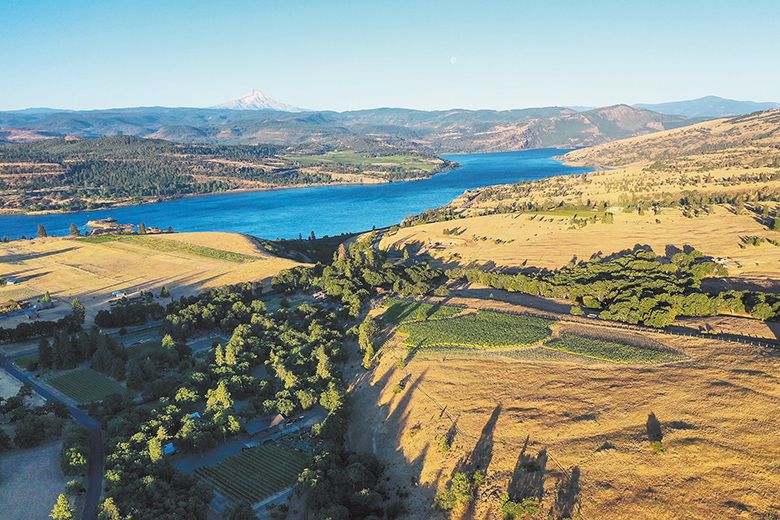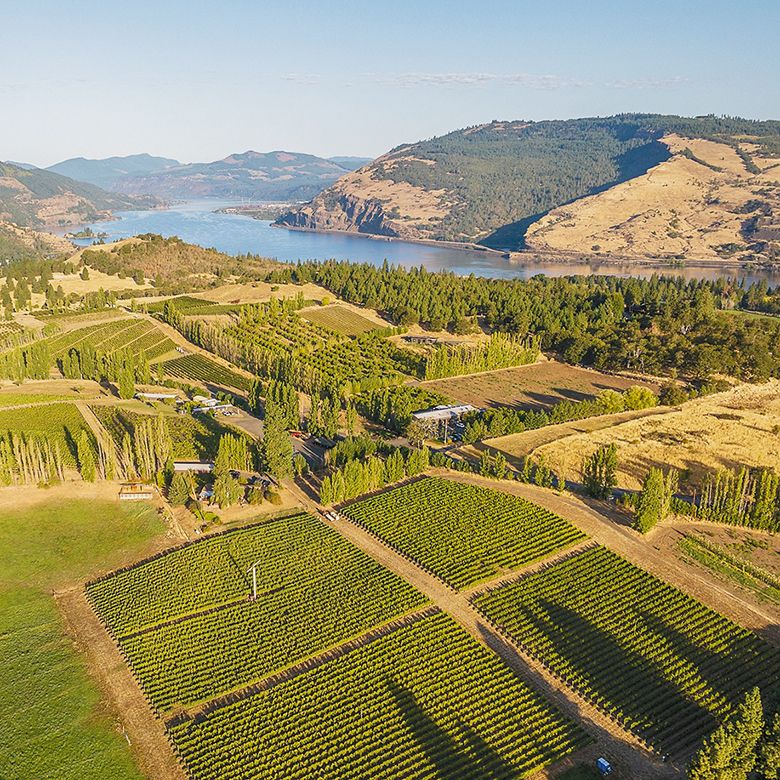Two Faces of the Columbia Gorge
Learn more about how the topography and climate influence the wines




By Aakanksha Agarwal
“Tortured topography.” James Mantone, head winemaker at Syncline Winery, chooses an interesting adjective to describe the terrain of the Columbia Gorge. Syncline, a boutique winery known for its Rhône-inspired wines, is in scenic Lyle, a quaint town in Washington. Mantone and wife, Poppie, belong to the intrepid group that founded the Columbia Gorge American Viticultural Area, or AVA, in 2004.
In the Gorge, winemaking remains a thrilling expedition. Picture this: vineyards dramatically etched into steep slopes, where the climate transitions from lush to parched in a mere breath. This single AVA straddles both Oregon and Washington, stretching across an impressive 40-mile swath, divided by the Columbia River. Over 50 grape varieties are planted, covering more than 1,300 acres of varied terrain.
Mantone notes, “At Syncline, we find inspiration by crafting wines that mirror the untamed spirit of the Columbia Gorge. Our grapes grow in hillside vineyards, exposed to the elements, where the raw energy of the earth reverberates through everything.”
For Mantone, the allure of the Gorge was undeniable. “It’s like nowhere else– raw, unapologetic… and utterly beautiful. Back in 1999, while Poppie and I were both working in the Willamette Valley, we found ourselves drawn to this rugged beauty,” he recalls. “We visited the Gorge often to whitewater kayak and became captivated by the potential for winemaking.” Inspired by the area’s rich fruit-growing legacy, they realized wine grapes would fare well too. This is true throughout the Gorge– vineyards are punctuated by vast orchards heavy with pears, peaches, apples, cherries and strawberries– an indication of the land’s bounty.
Crossing to Oregon, Steven Thompson, co-founder and vigneron at Analemma Winery, agrees with this philosophy. “Within the Columbia Gorge, it’s a unique and very dramatic landscape,” Thompson reflects. “Changes happen rapidly here; you don’t have to go far to experience great transformations. At Analemma, we’re in a sweet spot of the Gorge. The Mosier Hills are centered in the middle– bordered by the cooler western Hood River and warmer eastern area near The Dalles. It’s like having two worlds at our fingertips.”
“Hood River Valley grows a lot of Burgundian varietals like Pinot Noir and Chardonnay,” he continues. “The Dalles is better suited for Italian varietals such as Zinfandel, Nebbiolo and Sangiovese. At Analemma, with our mid-season ripening, we’ve chosen to grow varietals from Spain, particularly from Galicia– Mencia, Albariño, Godello, Trousseau, Grenache and Syrah.”
The unique geography of the Gorge, with the Cascades’ rain shadow effect, not only shapes the landscape but also influences winemaking. In the west, the Cascades trap moisture, ideal conditions for verdant vineyards and high-quality wines. Meanwhile, the drier east side poses its own set of challenges and opportunities for winemakers, leading to numerous grape varieties and unique wine styles. Imagine vineyards clinging to slopes influenced by both alpine conditions and coastal moisture, producing a mere 10 inches of rain in the arid east and a profuse 50 inches in the western foothills.
“And then there’s all the geological drama,” adds Thompson. While the Columbia River neatly divides the AVA by state, the actual difference in the Gorge is geological, not geographical. “One of the most important points of differentiation is elevation,” he remarks. “Millennia ago, cataclysmic floods sculpted the land, leaving behind a patchwork of volcanic soils and sedimentary deposits that give rise to an unparalleled diversity of terroir. Because of the Missoula Floods, we have volcanic-origin soils in vineyards perched above 1000 feet and flood-deposited soils below. This geological boundary influences everything, from the flavors in the grapes to the nuances in the wines.”
“Elevation is key,” explains Mantone from his position in Washington. “Another interesting thing with elevation is its impact on ripening. The region cuts through the Cascade Range so weather patterns move from west to east. The mountains act as a natural barrier, channeling weather patterns in ways that shape our wines. It’s a dance between sun and rain, warmth and coolness. The western side is cool and wet, whereas the eastern side is warmer and drier. It’s a distinctive kind of difference.”
And which varietals thrive in this challenging landscape? Here, it means embracing the extremes. In the cooler western reaches, Pinot Noir, Chardonnay, Gewürztraminer and Pinot Gris reign supreme. But venture eastward to encounter Cabernet Sauvignon, Viognier, Gamay, Syrah and Zinfandel thriving in the warmer, drier climate.
“In the Columbia Gorge, change is the only constant,” concludes Thompson.
Aakanksha Agarwal is a wine, travel and lifestyle writer from India. Formerly a Bollywood stylist, she now resides in the U.S., embracing writing full-time while juggling family life and indulging in her passions for cuisine, literature and wanderlust.










